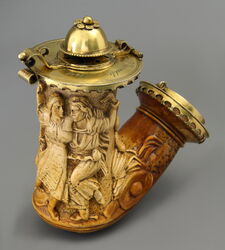Exuberant dance party
September 2023

According to the engraving on the lid ring, this pipe bowl came into the possession of Pertichevich Horvath in June 1831. His name, which means nothing to us anymore but is still a common family name in Hungary, is engraved in the rim of the lid in graceful curling letters. In a film recording almost a century and a half later, the previous owner, the Swiss collector Jacques Schmied, praised this pipe as the only meerschaum pipe with a gold lid. Unfortunately, that is not true for two reasons. Firstly, the lid is not solid gold but gilded silver. Moreover, meerschaum was often seen as expensive and was indeed sometimes provided with a golden lid or mounting. Still, the lid is a prominent part of the pipe. For others, however, it is about the carved representation all around. At the front of the cylindrical pipe bowl, a man and a woman dance passionately, he with his spur boots and his open blouse looks like a tough Don Juan. The music for the dance is provided by a three-man orchestra that we see on the side. In addition to a violinist and a cellist, a third man plays the bagpipes. Thanks to the swinging movements of the dancing couple, the music almost seems to rise above the pipe. Despite the lively figures and smooth depiction, the carving does not show great delicacy. It is rather sketchy, skilfully executed but not very artistic. The finish of the shrine scene, in which the background behind the figures is often provided with dots, is also somewhat hasty and minimal here. An interesting detail about this pipe is that the underside of the stem and the bottom of the pipe bowl have a beautiful neo-Gothic decoration consisting of quatrefoils. This decoration is in line with the date of the thirties of the nineteenth century, during the short-lived revival of the Gothic style.
Amsterdam Pipe Museum APM 24.680
Archive object of month